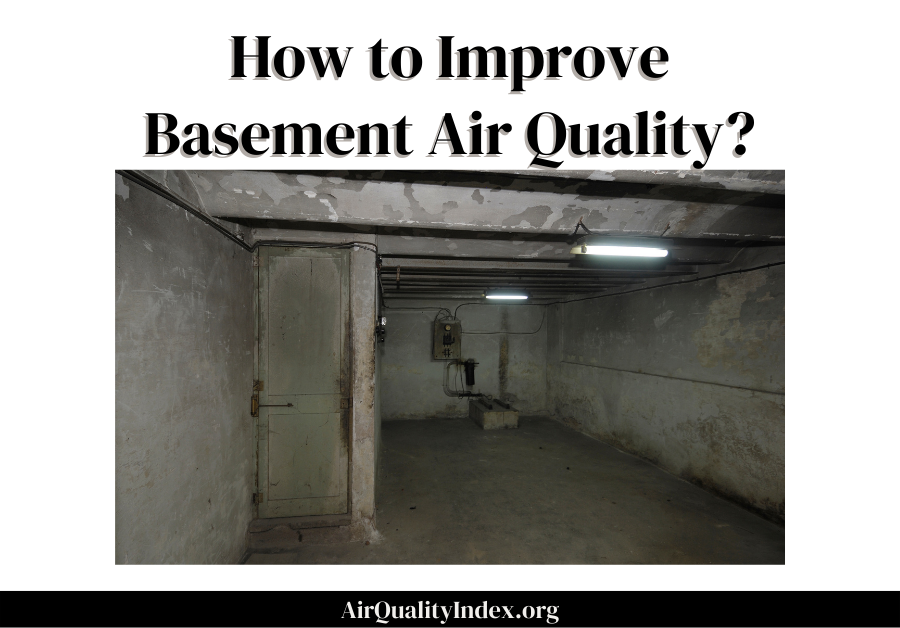Basements are fantastic for extra living space, but there’s a disadvantage to this. Stale basement air can’t be moved or the temperature can’t be maintained because of the limited ventilation in the area. The worst part is that basements sometimes have a musty odour or even attract mould.
Basements are usually ignored in some homes, leading to dangerous levels of pollution. However, if you know how to increase basement air quality, this won’t be a problem.
It’s not an easy task to improve the air quality of your basement. In some cases, you may require more than an air purifier.
How to Improve Basement Air Quality
A filthy, musty basement is the last thing anyone wants to deal with. In order to prevent this area of your home from becoming an allergen hotbed, do the following steps:
1. Clean The Air
Cleaning the air is the simplest technique to enhance the quality of the air in a basement.
You’ll need an air purifier to do that.
The toxins in the air are removed by air purifiers, which circulate the air through a series of filters.
Among these include allergies, mold spore, germs, and many other minute particles.
You’ll need an air purifier with specific functions in order to get the best possible air quality.
They include; a True HEPA filter, an Activated Carbon filter, and a UV light.
This set of features can get rid of musty smells and kill germs. Together, they can get rid of up to 99.97% of harmful airborne particles as small as 0.3 microns.
2. Clear Away The Mess
Your basement should be cleared of all the garbage. Many of us are guilty of using our basements as storage areas until they are ignored and left to rot.
Make sure to get rid of old containers, books, newspapers, and the like. Termites and rats are attracted to these things, which not only serve as breeding grounds for molds but also serve as food sources for them.
For those who don’t have the time or inclination to clean up their old possessions, you can either donate them or call a cleanup agency. Remember that your basement is the primary source of poor indoor air quality.
Organizing your basement into sections and tackling each section one by one will save you time and frustration. Setting a deadline for each part can help you stay on track and avoid becoming distracted.
Set out two separate bins: one for garbage and one for stuff that can still be sold or donated. Put on a face mask and gloves first!
3. Improve The Ventilation
Having a well-ventilated basement is critical to maintaining a healthy indoor environment. In a basement with poor ventilation, mold and mildew are more likely to grow. This is bad for your family’s health.
Adding a fan to remove stale air from the basement or utilizing natural ventilation can also help with ventilation.
4. Test The Indoor Air
The next step is to perform an indoor air quality test once you’ve cleaned the clutter. Indoor air quality monitors can be used, but if you want a more accurate reading, you can hire an expert.
Radon gas should be checked specifically. When uranium in rocks, soil, and water starts to break down and seeps into your basement, an odorless gas is produced. Consider the fact that 21,000 people die each year from lung cancer caused by radon gas in the home.
Carbon monoxide, another deadly but odorless gas, should also be checked for in your basement along with radon.
Mold, volatile organic chemicals, formaldehyde, asbestos, PM 2.5, PM 10, and PM 1.0 testing are also critical. Testing is simplified for consumers because professionals have a comprehensive list of these contaminants.
Testing your basement’s indoor air quality will allow you to see what, if any, improvements need to be made. However, if the tester discovers hazardous gasses and contaminants, they will recommend professional cleaning to remove them.
5. Seal The Gaps and Cracks
In the basement, cracks and gaps around the foundation walls, windows, and doors can lead to greater humidity levels and contaminated air entering the area.
Use caulk or expanding foam to fill in any cracks and gaps around the perimeter of your basement to safeguard the air quality.
6. Close The Windows
First thing that springs to mind when you think of ventilation is opening the windows. However, I’d like to put a stop to that!
As much as basement windows can aid in ventilation, they can also raise the risk of condensation. This occurs when the cool basement air meets the heated outdoor air. When this happens, mold begins to form because moisture is trapped on the surfaces. Before you know it, the humidity in your basement will rise over 60%!
Pollen and dust are also common allergens in summer outdoor air.
7. Remove High VOC Sources
Paints, stains, lacquers, and gasoline are just some of the chemicals and solvents that many of us keep in our basements.
The vapors from these “volatile organic compounds” (also known as “VOCs”) can accumulate to dangerous levels in basements with poor ventilation, which worsens the already poor air quality.
Ideally, you should try to get rid of these high VOC sources from your basement.
The best place to store these containers is in the garage or the outside shed.
Keep hazardous vapors at bay by discarding chemicals and solvents that you won’t be using in the near future.
8. Get Rid of Plants From The Basement
Adding a few potted plants to your basement seems like a good idea. However, before you transform your basement into an indoor garden, you should rethink your decision.
Plants, of course, produce oxygen and purify the air. However, it is of limited use when dealing with volatile organic compounds.
Potted plants can also increase the humidity in your basement by absorbing moisture from the soil they’re in. This should not be done in a home that is prone to mold. Potted plants may, in the long run, do more harm than good to the quality of your home’s air.
In order to improve the quality of air in your basement, you should use an air purifier. It’s more efficient than plants, and the results are always assured.
9. Control Humidity Levels
I’ve said it before and I’ll say it again: humidity in your basement can be both a friend and an enemy. Mold thrives in moist conditions, and this can have a negative impact on indoor air quality.
Low humidity, on the other hand, will irritate your eyes and throat. As a result, striking the appropriate balance is critical if you intend to turn your basement into livable space.

While a dehumidifier can help with the problem, you should not leave it running all the time. Relative humidity levels between 30 and 50 percent are generally considered ideal. This indicates that the interior air only holds 30 to 50 percent of the maximum quantity of moisture it can carry.
Humidity control can be difficult, especially when temperatures soar in the winter and summer. Never be afraid to seek expert help if your own attempts fail.
10. Dry Out Your Basement
Dampness and humidity are the root of many basement air quality issues.
You can remove a lot of these problems that generate musty odors and that “icky” feeling in your basement by drying it out.
Mold and mildew thrive in a damp environment, which is why basements should be kept dry.
Unfinished basement ceilings, joists, walls and floors can easily be seen with visible mold.
In a finished basement, mold may be covered beneath drywall, carpets, or ceiling covers, so you won’t be able to see it.
To make matters worse, exposure to mold can lead to a number of unpleasant side effects such as a runny nose and itchy eyes as well as a host of respiratory and health issues.
You must dry out your basement in order to avoid mold from forming and to stop it from spreading.
In order to thrive, mold requires an abundance of moisture.
Installing a dehumidifier in your basement is the most straightforward solution.
Relative humidity in the air can be reduced with the use of a dehumidifier.
You should strive for a percentage of 30 to 50 percent. Anything less than 50% will stop mold from growing.
Final Note
You don’t have to put up with poor air quality in your basement any longer, now that you know how to fix it.
A clean, dry, and fresh-smelling basement can be yours if you follow the advice in this article.




